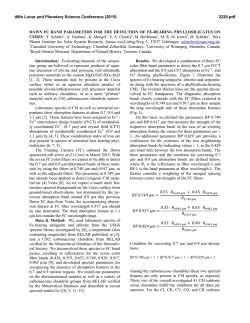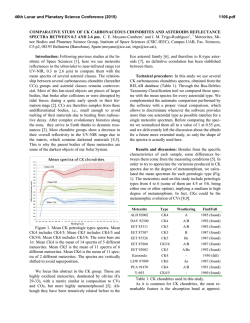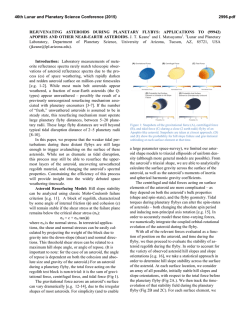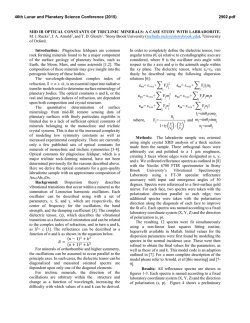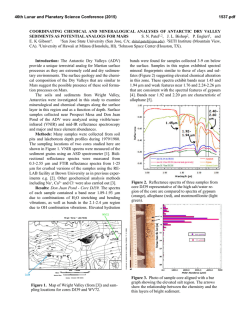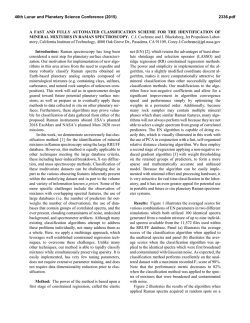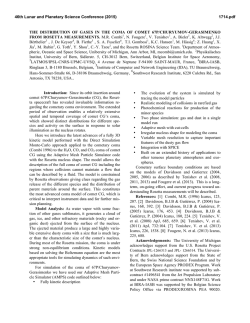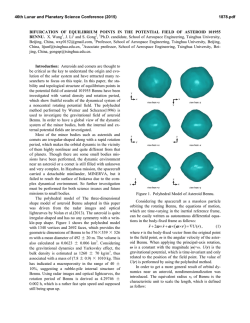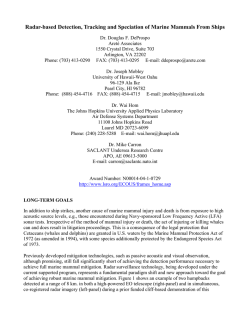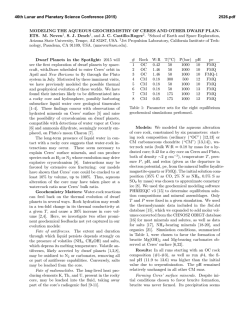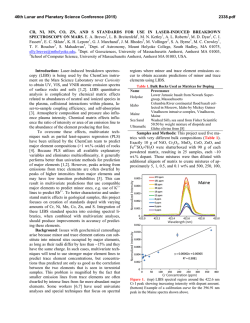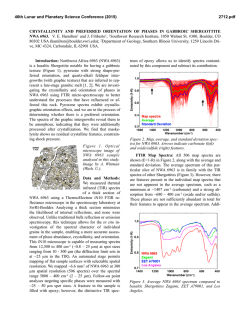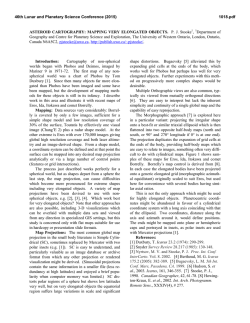
IMPROVED SHAPE MODEL OF 1627 IVAR. Jenna L. Crowell1
46th Lunar and Planetary Science Conference (2015) 2151.pdf IMPROVED SHAPE MODEL OF 1627 IVAR. Jenna L. Crowell1, Ellen S. Howell2, Christopher Magri3, Yanga R. Fernandez1, Sean E. Marshall4, Brian Warner5 and Ronald J. Vervack, Jr.6, 1University of Central Florida, Orlando, FL, USA. 2Arecibo Observatory, Arecibo, Puerto Rico. 3University of Maine at Farmington, Farmington, ME, USA 4Cornell University, Ithaca, NY, USA 5Center for Solar System Studies - Palmer Divide Station 6The Johns Hopkins University Applied Physics Laboratory, Laurel, MD, USA Introduction: 1627 Ivar is an Amor class near Earth asteroid with a taxonomic type of Sqw, [1] and a rotation period of 4.7979 ± 0.0001 hours [2]. Ivar was the first asteroid to be imaged by radar in 1985 at a resolution of 4 Hz [3]. These radar images show Ivar to be elongated with estimated dimensions of 11.5 x 6 km [3]. Its large size and close approach to Earth in 2013 (minimum distance 0.32 AU) provided an opportunity to observe the asteroid over many different viewing angles for an extended period of time. Here we present an improved shape model for Ivar using these data. Observations: During Ivar’s apparition, we were able to obtain CCD light curves, radar delay-Doppler data, and near-IR spectra. Radar delay-Doppler data consists of CW runs and imaging with 300 m resolution and were obtained using the Arecibo Observatory’s 2380 MHz radar. Light curve data were gathered using the 0.35m telescope at the Palmer Divide Station. The NIR spectra encompass reflected and thermal wavelengths (0.8 – 4.1 µm) and were acquired using the SpeX instrument at the NASA IRTF. Background: We have used the software SHAPE [4] to incorporate these recent radar and light curve datasets in order to determine the best shape model for Ivar that updates the results presented by Kaasalainen et al. [5], which were based solely on light curves. Figure 1 shows both the original light curve model by Figure 1: The model on the right illustrates the nonconvex model of Ivar by Kaasalainen et al. while the one on the left demonstrates the features that begin to take shape in the fitting process run by SHAPE. Kaasalainen et al. and an enhanced model produced by shape that provides a closer match to the 2013 data. Our approach is similar to that of Magri et al. [6] for 1580 Betulia. The software uses penalty functions and parameters that must be tailored specifically to the target asteroid in order to steer asteroid shapes away from those that are overly complex and implausible. Figure 2 illustrates the results of not using proper penalty functions. SHAPE produces synthetic light curves and radar images Figure 2: This model represents the “best fit” probased on the resulting duced by SHAPE without shape model that can appropriate penalty functhen be compared to the tions to provide reasonable constraints. original data. The results of our work clearly demonstrate the merit of combining the additional delay-Doppler data. Future work: We will include using the resulting shape model of Ivar with our thermal-modeling code SHERMAN [7,8,9]. Input parameters for SHERMAN include the asteroid’s IR emissivity, optical scattering law and thermal inertia in order to complete thermal computations based on the shape model. The software then creates synthetic near-IR spectra that can be compared to our own spectra, which cover a wide range of Ivar’s rotational longitudes and viewing geometries. The spectra show changes with rotation and phase angle. SHERMAN lets us determine which reflective, thermal, and surface properties for Ivar best reproduce our spectra. For example, we will be able to investigate the effects of phase reddening on Ivar and compare these with the results of testing phase reddening effects on crushed samples of ordinary chondrites in a laboratory [10]. With these comparisons and the results pro- 46th Lunar and Planetary Science Conference (2015) duced by SHERMAN, we will learn more about the detailed regolith and surface properties of Ivar and how those properties compare to those of other S-complex asteroids. References: DeMeo et al. 2009, Icarus 202, 160180. [2] Hahn, G. et al. 1989, Icarus 78, 363-381. [3] Ostro, S. et al. 1990, Astron. J., 99, 2012-2018 [4] Magri, C. et al. 2011, Icarus 214, 210-227. [5] Kaasalainen, M. et al. 2004, Icarus 167, 178-196. [6] Magri C. et al. 2007, Icarus 186, 152-177. [7] Howell, E. et al. 2012, AAS/DPS 44. [8] Marshall, S. et al. 2013, AAS/DPS 45. [9] Crowell, J. et al. 2014, AAS/DPS 46. [10] Sanchez, J. et al. 2012, Icarus 220, 36-50. We thank NSF (AST-1109855) and the CLASS SSERVI for their support of this work. 2151.pdf
© Copyright 2025
